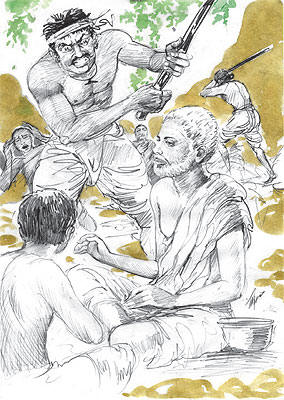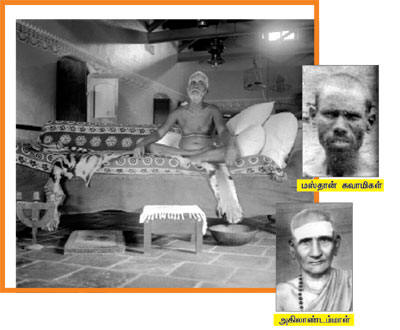Sakti Vikatan 04 Oct, 2011
In those days of meager medical facilities, it was difficult to escape
from the Plague. Ramanatha Brahmachari survived the bubonic plague
because of help from SriRamaṇa Maharishi.
When Srīramaṇar came down from the cave to Ramanasramam
as his permanent residence, Brahmachari continued to do his service. The
newcomers to the Āśramam receive a Palmyra leaf spread as a bed and a
log of wood as a pillow. Brahmachari gave away a loincloth to Mahatma
Gandhi he made with his spun cotton thread and woven cloth.
Venkatramaiah, Visvanathaswamy, Kunju Swamy… built living quarters in
the Jackfruit grove and lived there. Ramanatha was assigned the cleaning
detail here. They called him ‘Jackfruit dictator.’
This moniker reached the ears of Ramanar and he approved it.
He received a great respect from other devotees for his services without
recompense. One day he withheld eating his meals; upon enquiry, it was
found it was a death anniversary of his father. “Is that so?
Serve two more Iddlis to him,’ came the order from Bhagavan.
Making note of it, Rajagopalan said, “Hereafter, I will not observe death
anniversary fasting for my father.” The declaration reached the ears of
Bhagavan. ‘Ramanathan gave up everything and came here. What did
Rajagopalan give up?’ said Bhagavan. Ramanathan Brahmachari famous for
his renunciation like Bhagavan, died in Chennai in 1942 and reached
Paramapatham (Vaishnava heaven). Ramanatha Brahmachari showed by living
a life of sacrifice that service to devotees was Guru Puja. He was a
rare birth. He was an exemplar.
Because of merit from past life, he was lucky to go into Samadhi
frequently. But, some did not understand it. Bhagavan with prior
knowledge brought a devotee Akhilāṇḍa
Ammaiyār
to Tiruvannamalai. When Musthāṉ
Swāmigaḷ saw Bhagavan for the first time, Bhagavan was seated like a
stationary statue. His eyes shed a torrent of tears of mercy. This
touched Musthāṉ and created changes in his mind. Bhagavan was still deep
in meditation for eight hours. Only a few of the visitors to Bhagavan
are mature in meditative practices. They were the epitome of meditative
practices. Bhagavan spoke
of Musthāṉ in these terms. As he approached Virūpākṣi cave, he will go
into deep meditation. He was self-effacing. He remained in the
background not wishing for attention. When Dēsiramma
had provisions, utensils… to prepare food for Bhagavan, Musthāṉ brought
them up the mountain as a great service to Bhagavan.
A mongoose ran around and sat on the lap of Bhagavan frequently.
Bhagavan fearing the mongoose injuring the peacocks has a stick to chase
it away. One suggested to have it tied down so it becomes a pet.
Bhagavan ruled it out and said, ‘The animals visiting him are Siddha
Purushas, coming for Darśan. Please try to understand it.’
Musthāṉ once with devotees went on a begging tour of the town and
brought food. The food pile had a cooked egg. Everyone was shocked to
see it. Bhagavan threw away the egg and shared the meals with everyone.
He ate it too. With no hue and cry about Vedic injunctions on food
exclusions, Bhagavan showed his mental maturity to his devotees.
Swāmigaḷ’s health deteriorated and he died on November 8, 1938 on the
auspicious day of Deepāvaḷi.
His death was notified to Bhagavan. He asked Kuñju
Swāmigaḷ to attend the Samadhi ceremony in Matam village. Bhagavan gave
with his own hands sacred ash, camphor…for the Samadhi hole with an
explanation of procedural elements. Bhagavan honored them by giving the
Samadhi objects for his mother Azakambikai,
his cow Lakshmi, and Musthāṉ Swamy. Musthāṉ
being a Muslim enjoyed the friendship of Bhagavan upon his surrender,
and other devotees. It is an example of Bhagavan’s transcending of
religions.
When Bhagavan lived in the Virūpākṣi cave, his mother came there often.
She stayed in the homes of devotees in the foothills for the nights. The
devotees were afraid that Bhagavan will move away with his mother. They
ordered that women should not stay in Virūpākṣi cave. They misunderstood
the silence of Bhagavan. They imagined they knew better and talked about
restrictive rules. They behaved as if they were faultless. They used to
gloat that men were superior and women were inferior. If they had the
Light of Truth inside them, they would not have spoken against women.
They advanced many arguments against women.
Bhagavan wiped the floor with them (winning and defeating) and debunked their arguments against
women by saying, “Mother and the rest stay here; we will go to another
location.” The male-superior crowd sank in darkness. If the sun is to
move away, where is the world? They fell at his feet and begged for
forgiveness. Ok, accepted. Bhagavan came back to his place. The
womenfolk of Ganapathi Muni family wanted to stay in Virūpākṣi cave.
Opposition was mounted. Gaṇapathy Muni exploded in anger. He said, “Wait
until the nightfall.” That night torrential rains, lightning, fierce
winds, thunder… descended on earth. The temple ceremonial processional
car was struck by lightning and burned to ashes. The womenfolk covered
themselves with blankets as per rules. But they needed a place to stay.

Kandasamy
is the servitor of Bhagavan.
He scouted the mountain and located a place and took Bhagavan to
see it. Bhagavan seeing the big moist rock approved it. He by himself
cleared the underbrush and with the stones on the mountainside built a
hall with two rooms. Kandasamy was a professional mason. He gave up
everything and surrendered to Bhagavan. His expertise has helped erect a
building on the mountain-after day and night toil, as praised by
Bhagavan. That building was named Kandasramam after the builder.
Ramanatha Brahmachari,
Musthāṉ
Swamy, Kandasamy…were the living lessons. They are the witnesses to
Śaranāgati. Guru takes them to liberation.
Kunju Swamy was intimately connected with the life story of Bhagavan.
Let us get Darśan.



